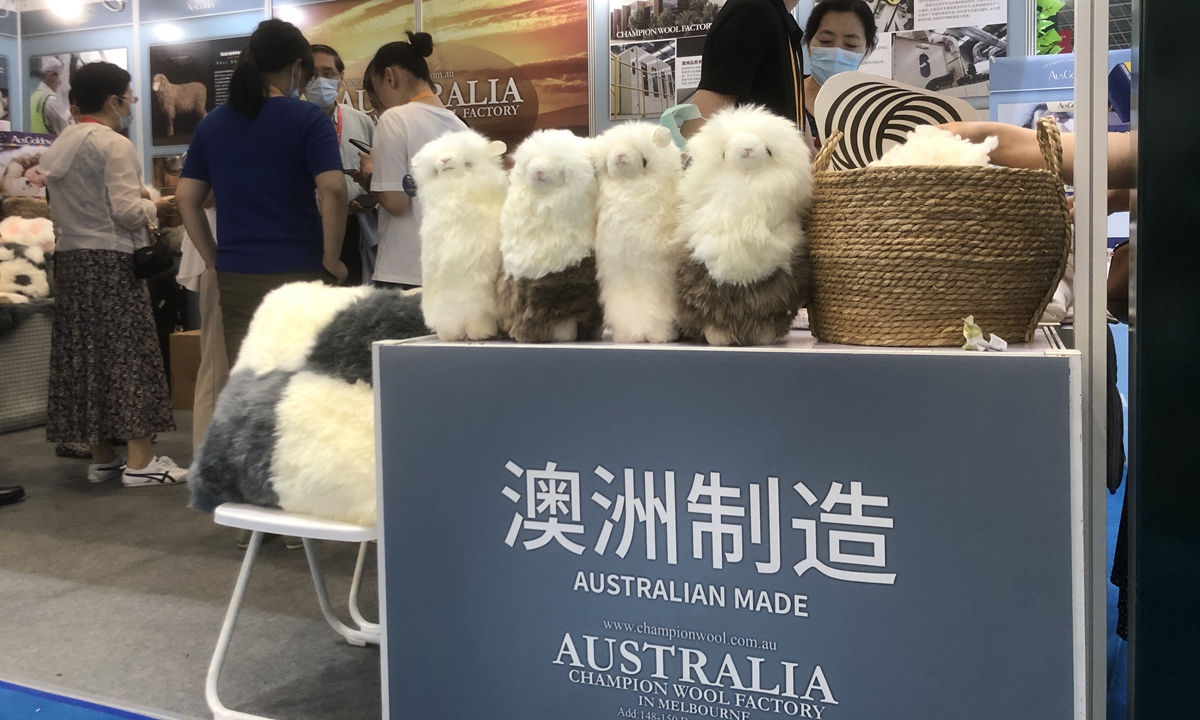
Australian firm Champion Wool Factory presents its wool products during the China International Consumer Products Expo in Haikou, capital of South China's Hainan Province on May 8, 2021. Photo: Zhang Hongpei/GT
China and Australia could reengage constructively to achieve win-win outcomes via developing mutually beneficial cooperation despite fraught bilateral relations over the past few years, and Australian businesses hold high expectations for opportunities emerging in the world's second largest economy, China-Australia Chamber of Commerce (AustCham China) told the Global Times recently.
The two sessions, namely the annual sessions of the National People's Congress, the top legislature, and the National Committee of the Chinese People's Political Consultative Conference, the top political advisory body, are a window to observe China's social and economic development priorities for the year and beyond.
AustCham members are interested to get to know the key content of the Chinese government's plans for the next 12 months. The government has pledged to shore up stability of its economy and financial market, while it has made significant progress in important areas such as sustainability, low carbon technologies, common prosperity and rural development.
Notably, epidemic prevention and control remain important. The COVID-19 pandemic continues to have adverse effects on China and other parts of the world, so it is anticipated that the two sessions will devote significant time to chart a way forward, said the chamber.
China on Saturday set a GDP growth target of around 5.5 percent for 2022, exceeding market expectations.
"Our members are interested to see how this growth target impacts economic and trade relations via imports of resources, commodities and agricultural products. Also, stable growth in China has flow-on effects for Australia's education sector and the services sectors," Nick Coyle, CEO of AustCham China, told the Global Times on Tuesday.
"We also expect considerable discussion on trade relations and China's position in the world, particularly pertaining to geopolitics, multilateral international institutions, and global governance," Coyle said.
The past year continued to be a tumultuous year for China-Australia relations, as the two nations fought on a number of issues.
Despite having a free trade agreement, the trade and investment outcomes over recent years for both countries have been suboptimal, the AustCham said.
"Our members strongly believe in the value to both China and Australia of strong economic and trade ties. The Australian and Chinese economies are largely complementary in structures, but have experienced difficulties with bilateral relations over recent years," Coyle said.
He emphasized the importance of recovering bilateral economic ties via mutually beneficial cooperation. "Considering the growing complexity and global uncertainty, now more than ever, Australia needs to strengthen its relationships with countries across the Asia-Pacific region," Coyle noted.
"Australian companies are enthusiastic about trade and investment opportunities offered by the RCEP deal and the growth prospects of China and East Asia as a whole," he added.
Trade between China and Australia stood at $231.2 billion in 2021, accounting for 3.82 percent of China's total foreign trade, which surpassed $6 trillion mark for the first time, according to statistics released by China's General Administration of Customs (GAC).
Total imports from Australia stood at $11.4 billion in December 2021, down 13.0 percent from $13.07 billion in November. But the imports from Australia for the whole year reached $164.8 billion, up 40.0 percent on a yearly basis.
Analysts said the increase in the value of China's imports from Australia was mainly due to the skyrocketing prices of goods, especially bulk commodities, and the low base of comparison from 2020.
In 2020, China imported $114.8 billion worth of goods from Australia, down by 5.3 percent from 2019, per GAC data.




